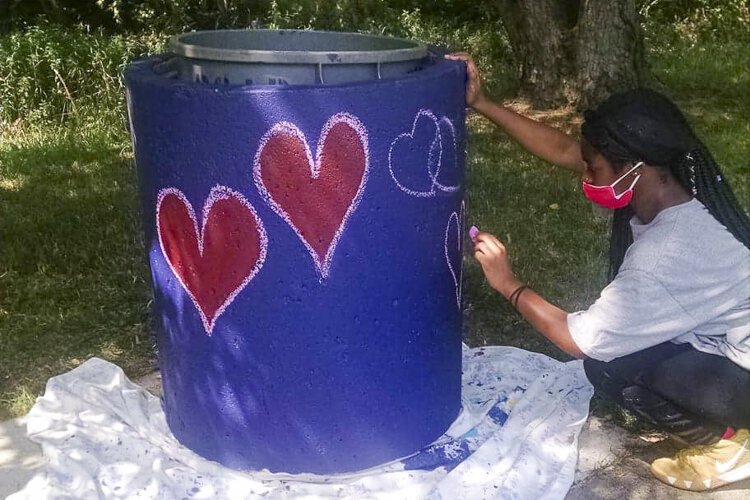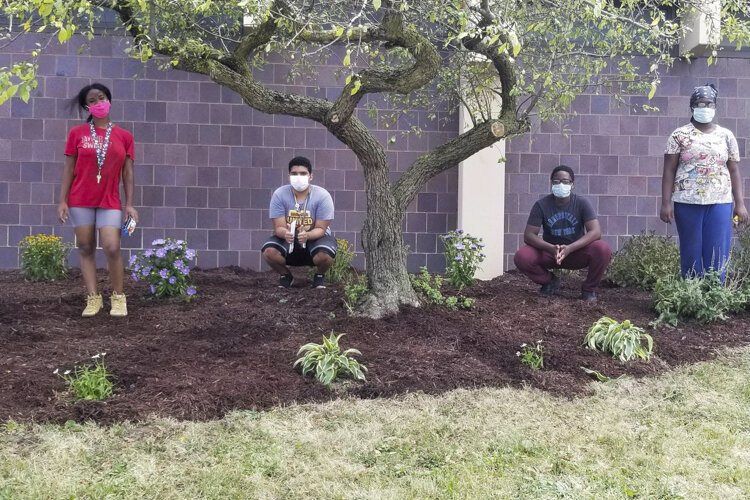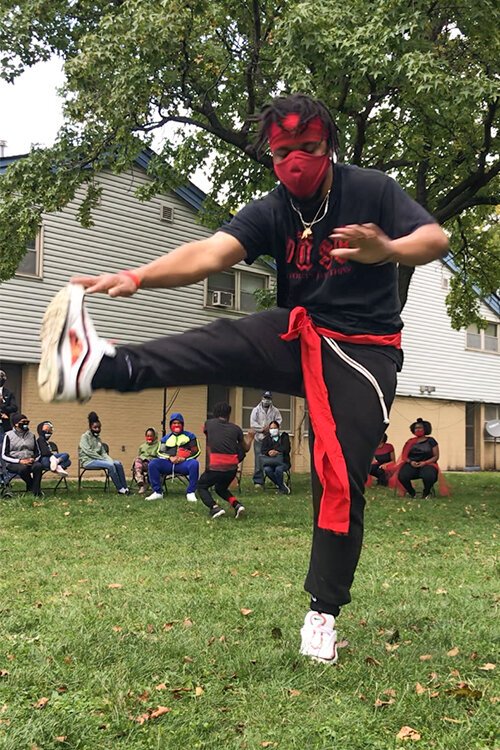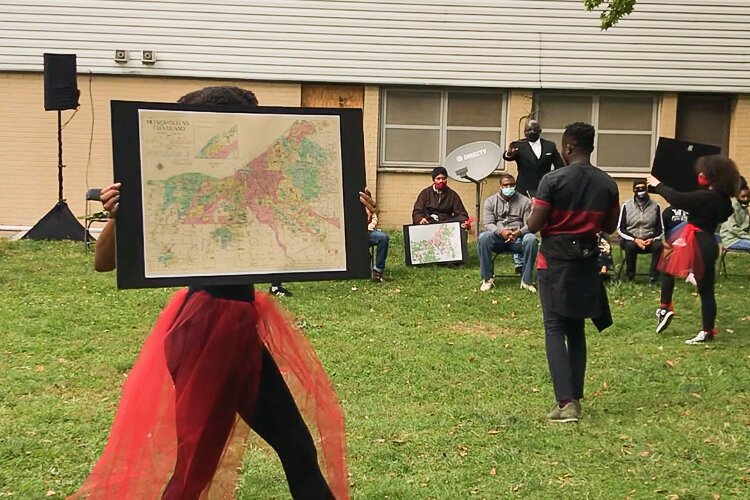Finding opportunity in the pandemic: How CDCs use programs to champion Cleveland’s youth
This is the first story in FreshWater’s new yearlong series, Community Development Connection, in partnership with Cleveland Neighborhood Progress and Cleveland Development Advisors and funded in-part by a Google Grant. The series seeks to raise awareness about the work of 29 Community Development Corporations (CDCs) as well as explore the efforts of neighborhood-based organizations, leaders, and residents who are focused on moving their communities forward during a time of unprecedented challenge.
As the COVID-19 pandemic continues to exacerbate high-risk health conditions, poverty, the digital divide, and much more this year in Cleveland, the city’s Community Development Corporations (CDCs) knew they needed to deliver youth programming to fill in the gaps.
CDC officials also knew that many young Clevelanders yearned for programs that would teach them how to impact their own lives and others in their communities.
“Because “Because this is a lived experience for young people, many of them are automatically interested in saving their own lives,” says Daniel Gray-Kontar, executive artistic director of Twelve Literary Arts. “They recognize that their lives are hanging in the balance.”
From placemaking to amplifying young voices, CDCs are engaging youth through impactful and unique programs. The shutdown required CDCs to adjust for survival, but the shutdown also provided an opportunity for the organizations to connect with young community members differently than they had before.
“Young people want to be involved,” says Lattimore. “It’s just about asking them, providing a platform, content, and removing barriers.”
 Teenagers in the Youth Opportunities Unlimited employment program doing beautification projects in the neighborhood.Creating new spaces for connectedness, learning and fun
Teenagers in the Youth Opportunities Unlimited employment program doing beautification projects in the neighborhood.Creating new spaces for connectedness, learning and fun
Although CDCs are historically and commonly known for their roles in housing and economic development, some began to expand their visions and purposes over the last 20 years to make youth engagement a high priority and focus area.
That focus only intensified amid the pandemic.
“We believe that youth development is community development because youth are a part of our community currently and will eventually become adults in our community,” says Vanessa Lange, youth development director at Bellaire-Puritas Community Development Corporation (BPCDC). “So, building up our youth is important to the health of our community.”
Partnering with schools is essential for the delivery of BPCDC’s services to students, who can attend after-school and summer camp programs and participate in activities, such as art, dance, science, and yoga. BPCDC transitioned programs offered throughout the year at sites like Robinson G. Jones School on West 105th Street and the Riverside Park Estates apartments to online platforms.
BPCDC successfully hosted its summer camp program via Zoom, partnering with local organizations such as Art House, Dancing Wheels, America SCORES, and others to provide specialized content and programming. The summer camp lasted five weeks and required the children to participate online twice a day for a total of three hours. The organization also hosted weekly pop-up sessions, where the participants met up once per week with an instructor to do in-person activities outdoors at a distance.
“We were able to keep the children engaged in the virtual and get them to come out and meet the other kids they were seeing on the screen,” says BPCDC’s Lange. “It helped to keep everyone connected and made it feel like a real community.”
BPCDC is in the process of starting a virtual after-school program and has a High School Youth Council, which normally would meet at John Marshall School of Engineering. The Youth Council has moved to a hybrid model and meets twice per week, via Zoom and in person.
During in-person meetings, Youth Council members work on community service projects. This year, members worked on a community garden and hosted a park cleanup event.
“We are trying to provide an outdoor, easy way for the kids to practice social distance, while also interacting with each other and doing something positive for the community,” says Lange.
Partnerships and collaborations create an ecosystem to develop young leaders
Lange attributes the success of these BPCDC programs to the organization’s partnership with MyCom, a network of youth-based organizations whose mission is to connect young people in Greater Cleveland with positive experiences and caring adults.
MyCom, a youth development program that connects young people to existing programs and resources for positive growth work using the arts, has been instrumental in providing funding and resources for youth-based initiatives for more than a decade.
The organization supports CDCs and neighborhoods by funding a full-time youth coordinator who works for the CDC and whose goal is to develop and implement youth programming.
 Teenagers in the Youth Opportunities Unlimited employment program doing beautification projects in the neighborhood.“MyCom has helped us provide funding to partners that want to do youth programming in our neighborhood and has helped build up our capacity and partnerships with the schools,” Lange says.
Teenagers in the Youth Opportunities Unlimited employment program doing beautification projects in the neighborhood.“MyCom has helped us provide funding to partners that want to do youth programming in our neighborhood and has helped build up our capacity and partnerships with the schools,” Lange says.
One of MyCom’s founding neighborhoods is St. Clair and Superior. The St. Clair Superior Development Corporation’s (SCSDC) teen center engages local youth, ages 13 to 19, and is supported with funds from MyCom.
As part of the program, teens lead cooking classes and bake sales, tend to the community garden, and participate in design/build and sustainability projects, says Philip Hewitt, former director of SCSDC youth programming. One sustainability project allowed the kids to install a small solar panel that powers air quality monitoring on St. Clair Avenue.
While most adolescent programs are designed by adults, SCSDC took a different approach and has incorporated programming designed and managed by youth. For example, its Garden2Kitchen program allows young participants to build and maintain the community gardens and then use the food from the gardens in their cooking classes.
The cooking classes are taught by teen head chefs, who can also obtain their ServSafe certification through this program.
“The kids have a lot of pride for their garden and the food they make in the kitchen,” says Hewitt. “You can see the level of ownership they have, and it makes them happy and proud of their own community.”
Using arts to amplify youthful voices
As investments in art education in schools continue to decrease, organizations such as MyCom are increasingly important in exposing youth to the arts.
“Arts are important to young people because they have so many important, valuable ideas and thoughts and very rarely do they have an actual platform to get their ideas and thoughts out,” says Alex Leslie, strategic community initiatives manager at MyCom.
While MyCom’s primary model is to provide funding and support services to youth-based initiatives, the organization has also created programs dedicated to the arts, such as Future Leaders of the World (FLOW) and MyMedia. Both programs provide platforms for youth to explore their talents and passions in various forms of art, such as poetry, storytelling, photography, and videography.
Although FLOW specifically focuses on engaging and educating youth on democratic and political processes, it incorporates writing and storytelling in its annual Soapbox speech competition.
MyCom replaced this year’s cancelled competition with an online version of all the students' works. The online book titled, Out of The Mouths of Babes, is a collection of 28 speeches written by high school students.
“We’ve done programs with the arts because an important part of our mission and goal is to provide youth a voice,” says Leslie. “There is no better way to provide youth a voice than providing them a platform through the arts.
“Supporting the arts program is crucial. Arts enhance everybody’s ability to learn in every other way and we need to have enhanced experiences that give us a chance to explore our soul.”
 MidTown Cleveland community dance, music, and poetry event earlier this month called "Freedom".Building structure around youth leadership
MidTown Cleveland community dance, music, and poetry event earlier this month called "Freedom".Building structure around youth leadership
Located in the heart of Cleveland and serving the commercial corridors of Euclid, Carnegie, Chester, and Payne, Midtown has engaged has engaged Cleveland youth by embracing local artists and promoting the idea that young voices are necessary in the design and development of their communities.
Through grant funding, MidTown has supported the work of Gray-Kontar and Lattimore on the E. 66th Street Corridor Transportation for Livable Communities Initiative. That work led to the formation of the Hough Youth Council, primarily facilitated by Gray-Kontar and Lattimore. The Council was birthed on the belief that youth and community residents should be included in placemaking and neighborhood planning.Council members engage in every phase of a project, from meeting design architects to working with zoning and city planning professionals and engaging with residents.
Elleana Tanks-Gabor, a 15-year-old member who lives and volunteers in the Hough neighborhood, initially joined the Youth Advisory Council because she was interested in helping people and making new connections.
“This experience has a teaching and educational component that is different from my community service work,” says Tanks-Gabor. “In this program, you actually have to sit down and learn about zone-based coding and the history of the community and then apply this knowledge and decide how to take action.”
When asked why she felt it was important for the youth to be involved she says, “The youth, we’re going to take over one day, and we should have a say in what changes we feel like we need to make our community a better place.”
Mary Barrett, another council member, agrees that Midtown’s approach to youth development has given teens a powerful and distinct voice in the redesign of their communities.
“If you don’t have a say in your home and what your neighborhood looks like, then you don’t have a say in anything,” says Barrett. “People should have a say in where they live and what they have access to.”

About the Author: Charmaine Jordan
Charmaine is a resident of Cleveland, where she works as a procurement specialist during the day and in her spare time is a freelance writer, blogger, and community change agent. She enjoys spending time with her family and volunteering with the non profit organization Men & Women of Central to help make a positive impact in her community. She aspires to one day become a best selling author.





